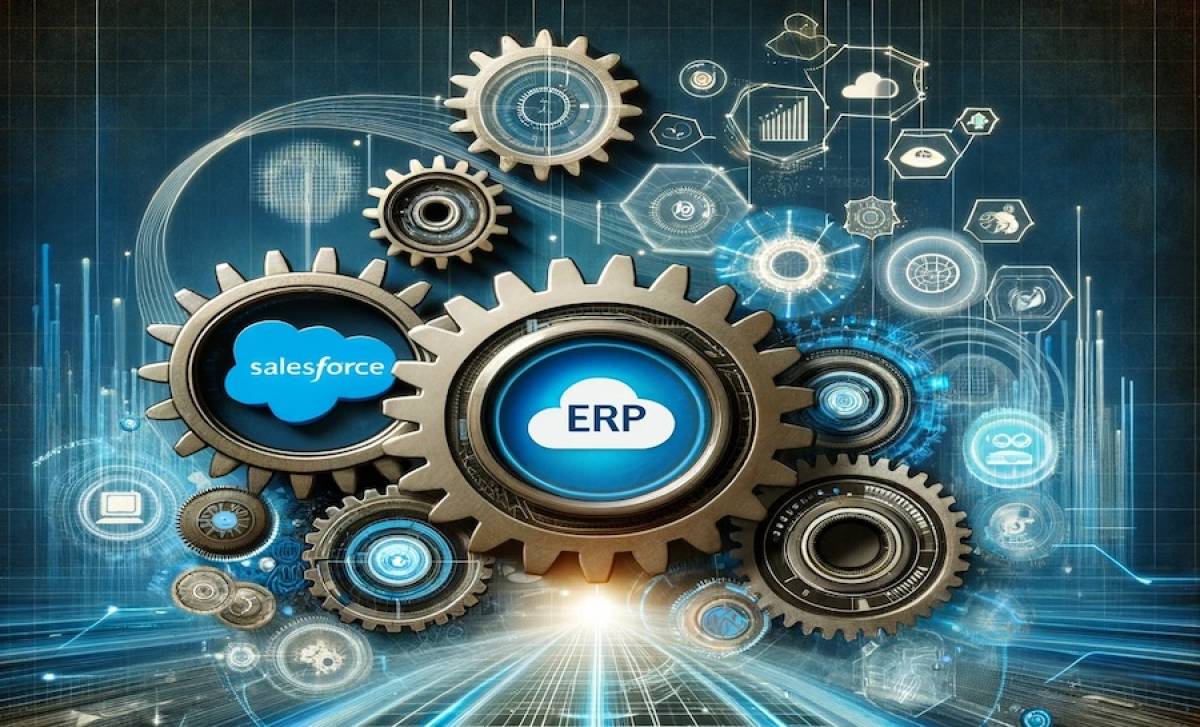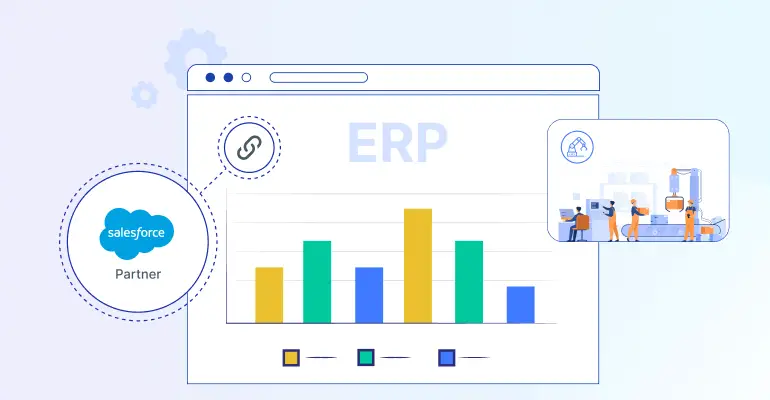How to Integrate Salesforce with Your Manufacturing ERP System

Integrating Customer Relationship Management systems like Salesforce with Enterprise Resource Planning (ERP) solutions is mandatory for modern businesses to enhance the efficiency of the work process and to get a holistic view of operations. This integration is a vital step towards getting a comprehensive view of the business operations. It is a cornerstone for modern businesses aiming to gain operation efficiency and customer interaction management.
Understanding the Imperative of CRM-ERP Integration
The Salesforce platform is especially known for its CRM capabilities, which include sales processes, customer engagement, and wise management of customer data and interactions.
On the other hand, the ERP platform streamlines business operations, production planning, and supply chain management.
Combining these two components results in data accuracy, business intelligence, and heightened operational efficiency.
Selecting the Ideal ERP Solution for Salesforce Integration:
Selecting the ERP system that aligns perfectly with Salesforce is mandatory to follow the seamless integration. Some of the best ERPs for salesforce integration are SAP, Microsoft Dynamics, and Oracle. For successful integration, the major factors to look after are scalability, industry relevance, and Customization capabilities.
Key Considerations in Salesforce-ERP Integration
1. Data Mapping and Alignment:
Firstly, identify the data points that must be synchronized between Salesforce and ERP. This step creates the base and firm foundation for seamless data exchange. To maintain data integrity at both ends, ensure the alignment by mapping the whole field.
2. Integration Architecture:
The architecture that suits your business needs is the one to be chosen. Middleware solutions like Dell Boomi and MuleSoft can be utilized, or point-to-point integration can be done for the needed results. Middleware provides a centralized hub for reducing the dependencies on direct point-to-point connections and simplifies the integration process.
3. API Integration:
Salesforce API (Application Programming Interfaces) can be used to communicate seamlessly between both ends. Having a robust and secure API provides immediate updates across both Salesforce and ERP while providing real-time data synchronization.
4. Customization and Configuration:
To meet specific business requirements, tailoring the integration is necessary, which includes creating triggers, customizing workflows, and configuring automated processes. Ensuring that the integration adapts to the existing manufacturing workflows and operational nuances is mandatory.
5. Data Security and Compliance:
Implementing the user authentication and encryption protocols prioritizes data security. Also, regularly conducting security audits to identify vulnerabilities is mandatory, especially for industry-specific regulations to safeguard sensitive information.
Step-by-Step Guide to Salesforce-ERP Integration

1. Define Integration Objectives:
Clearly outline the aimed objectives of the integration. Determine wisely which data points should sync between the ERP and Salesforce systems.
2. Choose Integration Method:
Choosing the integration method that suits the business needs is mandatory. This can include the pre-built connectors provided by ERP vendors, middleware solutions, and point-to-point integration.
3. Map Data Fields:
To ensure the harmonized flow of information across the Salesforce and ERP, mapping the corresponding data fields is necessary.
4. Configure Integration Settings:
To configure the settings and establish the connection between Salesforce and ERP, use the chosen method on the basis of mandatory factors.
5. Testing:
Before deploying the integration in the live process, thoroughly test it within the systems. Ensure that all the actions are triggering as expected and verify the accuracy of data with response times on actions.
6. Deployment and Monitoring:
After the successful testing, deploy the integration in the live system. Regularly monitor the system and address the issues promptly.
Best Practices for Salesforce ERP Integration
1. Maintain Documentation:
Thoroughly document the integration process, including data mappings, configurations, and API connections. This documentation serves as a valuable resource for troubleshooting, future updates, and onboarding new team members.
2. Regular Updates and Optimization:
Stay abreast of updates to both Salesforce and the ERP system. Periodically review and optimize the integration to accommodate new features, address performance issues, and enhance overall efficiency.
3. User Training and Support:
Provide comprehensive training to users who interact with integrated systems. Ensure that they understand the nuances of the integration, know how to troubleshoot common issues and leverage the integrated capabilities effectively.
4. Scalability Considerations:
Plan for scalability from the outset. As your business grows, the integration should seamlessly accommodate increased data volumes and evolving business processes. Regularly reassess and enhance the integration to align with your expanding business needs.
How Salesforce-ERP Integration Enhances Operations and Customer Experience
1. Seamless Data Flow:
Integration ensures that data seamlessly flows between Salesforce and your ERP system. This means that customer information, order details, and other relevant data are automatically synchronized, reducing manual data entry errors and saving time.
2. Enhanced Customer Experience:
Integrating Salesforce with ERP allows your sales and customer service teams to access real-time data. This enables them to provide customers with accurate information on order status, inventory levels, and delivery timelines, leading to an improved overall customer experience.
3. Efficient Sales Processes:
The integrated data also helps in making informed decisions. For example, one can directly check the product availability, pricing, and delivery schedules within Salesforce.
4. Improved Inventory Management:
The integration keeps the data up-to-date in both systems. This helps prevent fulfillment errors, overstock situations, stock loss, and stockouts. Eventually, this up-to-date information will aid in better and perfect production planning.
5. Streamlined Order Fulfillment:
When the Salesforce and ERP systems are integrated, the orders placed in the Salesforce trigger the corresponding next-step actions in the ERP systems. This enhances operational efficiency and order fulfillment.
Conclusion
Aligning Salesforce with your manufacturing ERP system represents a strategic initiative to amplify operational efficiency and bolster customer satisfaction.
The meticulous selection of an ERP solution and the adherence to a systematic integration are the foundation of the integration process. This is the key to unleashing the capabilities inherent in these potent platforms, getting the advantage within the swiftly evolving market landscape.




















